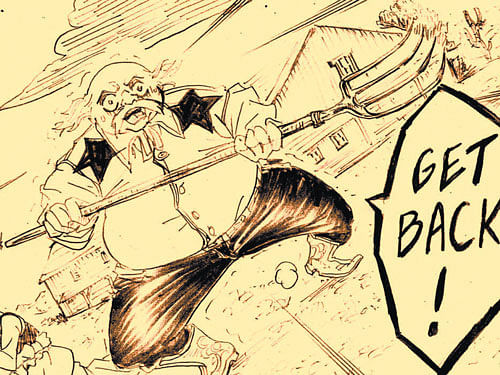When people realise you read manga (Japanese illustrations and comics) or that your longest relationship is probably with one the characters from your favourite series, a smug look appears on their face, before they belt lines like ‘You are this old and you read cartoons?’. This condescension is accompanied by various misplaced judgements on a subtle and detailed form of art that transcends mere ‘cartoons’.
The art form is typically associated with series such as ‘Naruto’ or ‘Cardcaptor Sakura’, which were the beginning of a colourful journey into the world of manga art in India, or shows like ‘Ninja Hattori’, ‘Doraemon’ and ‘Shinchan’, which are just a blemish on this vast industry. But as social media (and the internet at large) monopolise one’s time, it has become easier to access quality manga (and anime) and artists are having an easier time popularising their work. Now, Indian artists, including many from Bengaluru, have taken to drawing manga style and publishers are more willing to help them.
Typically drawn back to front and right to left, manga is penetrating the country at a slow but steady pace.
Brothers Ananth Maruthi and Gowra Hari Perla are the artists behind one of the few manga books from India, ‘Ka-Kaa: The Shaman Trials’. “One of the biggest challenges a manga artist has here is to find a publisher who is willing to publish a book that is read back to front. Also, they don’t want black and white drawings,” says Ananth.
Varsha Kodgi, a freelance illustrator who is enamoured by manga, adds that it is difficult to find the right supplies. “Although there are a few stores that sell brush pens and microtip pens, it is difficult to get the right kind of paper. Manga artists generally use a B4 size paper that comes with grids and bleed space, but we have to manage with whatever we get and draw our own rules.” However, others like Deeganto Joardar, a full-time artist, seem more positive. “When compared to say 10 years ago, there are more opportunities now. The only challenge I faced was convincing my parents that this is a viable career. My dad wanted me to have a fall back option and that’s why I studied architecture. These days people are looking to experiment and read unique styles,” he says.
Known for its distinct characters and style of drawing, manga is a self-taught art here. “There isn’t any literature on manga art. The ones that give you easy steps to draw manga aren’t helpful, and the good ones are in Japanese,” says Ananth. Varsha, too, began drawing manga from watching anime characters on TV. “Most design schools follow the Disney school of drawing and don’t encourage niche styles like manga. But there are a few who are opening up now,” she adds.
Ask an artist why they like manga and you’ll get an excited answer that resembles, “Even though they are just black and white drawings with minimal text, they are dynamic and each panel flows and creates a dialogue. The narration is good and every character has a role to play, unlike in comics like ‘Superman’, where all the characters only assist the lead. And the expressions are well-defined and text isn’t needed to tell a story.” Ananth also admits that he became a manga artist because it needs the least amount of investment. “When we started out, we spent Rs 500 on some paper and pencils!”
Varsha, who is inspired by ‘Clamp’, a group of manga artists known for works such as ‘Cardcaptor Sakura’ and ‘xxxHolic’, adds that manga is a source of recreation and learning. “I need it,”she says. It is this relatability that makes manga so appealing; it is not just a comic but an in-depth view of the human psyche and philosophical ideas. It also provides a clear view of Japanese culture and this style of drawing is now being incorporated to accommodate Indian themes and stories. Deeganto is working on illustrations of Indian culture, myth and folk stories, while Ananth tries his hand on the Jataka tales. But when there’s quality Japanese manga available for free on the net, why would people buy a book here? “It’s just a style of art and it’s not restricted to Japan. It’s like saying you can’t make noodles because it’s Chinese. Although there are many purists and naysayers, who aren’t very encouraging when I tell them about my book, there is a crop of people who are open to experimentation. Besides, holding a book is a different feel from reading something online,” says Ananth. While there is room for growth, many Japanese and US publications are already sniffing the grounds for up-and-coming artists.
